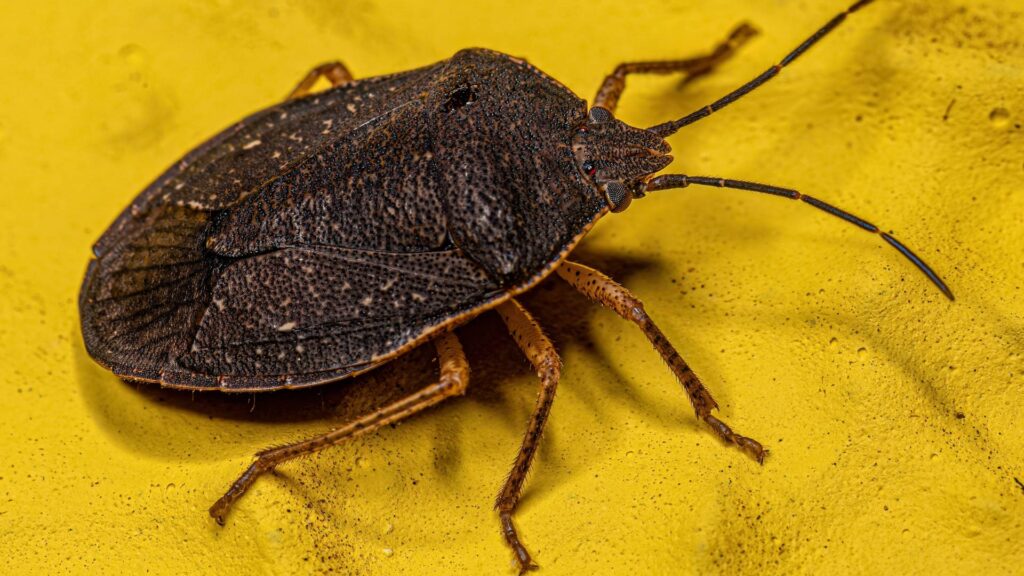Table Of Content
ToggleAs a pest control expert, I’ve encountered a wide array of household nuisances, but few are as troublesome as the brown marmorated stink bug.
Originating from Asia, this invasive species has spread across various continents, wreaking havoc in homes, gardens, and agricultural fields.
In this article, we’ll delve into the characteristics, threats, and management strategies for these pesky invaders.
The brown marmorated stink bug (Halyomorpha halys) has become a major concern in many parts of the world, particularly as they enter homes and become a problem. While their name might conjure images of dangerous pests, the reality is a bit more nuanced. This article dives deep into the brown marmorated stink bug, exploring its biology, potential dangers, and effective management strategies.
The brown marmorated stink bug is a shield-shaped insect roughly half an inch long. Its body is brown, marbled with lighter markings, and has a flat, angular back. They’re easily distinguished by their shield-like shape and the pointed projection at the “shoulder” area. These features make them instantly recognizable, even to those unfamiliar with insects.
Native to East Asia, the brown marmorated stink bug has become an invasive species in many countries, including the United States and Europe. They thrive in temperate climates and prefer areas with access to food sources like crops, fruits, and ornamental plants. During the fall and winter, they seek shelter in homes and buildings, becoming a pest.
Brown marmorated stink bugs reproduce once a year. Adult females lay eggs in clusters on the undersides of leaves in late summer or early fall. These eggs hatch into nymphs in the spring, going through five instars (developmental stages) before reaching adulthood in late summer. They feed on plant juices throughout their development, causing damage to leaves and fruits.
To learn more about their specific habitats and behaviors, consider exploring detailed insights on stink bugs.
Tailor your pest management strategy. Start now.

While not directly harmful to humans, the brown marmorated stink bug poses several threats:
Brown marmorated stink bugs are agricultural pests that feed on a wide variety of fruits, vegetables, and ornamental plants. Their feeding habits can cause significant crop damage, leading to economic losses for farmers.
Homeowners can also be affected by these pests. Stink bugs damage fruits, vegetables, and ornamental plants in gardens and yards. Their feeding can cause blemishes, stunted growth, and even fruit drop.
As an invasive species, the stink bug disrupts the natural balance of local ecosystems. They compete with native insects for food and resources, potentially impacting native plant populations.
While stink bugs don’t bite or sting, they emit a foul-smelling odor when disturbed. This scent can be unpleasant and persistent, making them a pest in homes. In rare cases, some individuals may experience skin irritation or allergic reactions from the stink bug’s defensive fluids.
Choose the best pest control frequency. Get expert guidance.

There are several ways to manage brown marmorated stink bug populations:
Important Note: Always identify the specific pest you’re dealing with before using any pesticide. Test any product in an inconspicuous area first to check for staining or damage.
Ready to fumigate your home? Contact us today for a customized quote!
If you have a severe stink bug infestation, consider contacting a professional pest management service. Professionals have access to stronger insecticides and can develop a targeted treatment plan to eliminate the problem.
What to Expect from Professional Pest Control Services:
A qualified pest professional will assess the extent of the infestation and recommend the most effective treatment plan. This may involve a combination of methods, such as barrier sprays, perimeter treatments, or targeted applications.
For comprehensive solutions, including pest control for ticks in the house, professional services offer tailored approaches. A qualified pest professional will assess the extent of the infestation and recommend the most effective treatment plan.
Understanding the cost of various pest treatments, such as bed bug house treatment, can aid in making informed decisions for pest management.

Don’t let pests take over your space. Get in touch now and reclaim your home!
Since the stink bug is an invasive species, community-wide efforts are crucial for effective management. Here’s how communities can work together:

In my years as exterminator, dealing with the stink bug has proven challenging yet manageable with the right strategies. Understanding their behavior, implementing preventive measures, and employing effective control methods can significantly mitigate their threat.
Proactive management and community collaboration are key in adapting to the ongoing challenge posed by this invasive species.
Stink bugs are not harmful to humans as they do not bite, sting, or transmit diseases. However, their presence can be a nuisance due to their large numbers and the foul odor they release when threatened or crushed.
If a stink bug bites you, it is usually a rare occurrence and not a cause for concern. Most stink bugs feed on plants and do not typically bite humans. In the unusual case of a bite, it might cause slight irritation or a red mark, similar to a mosquito bite, but no serious health issues.
Say goodbye to pests for good. Book your fumigation session now!
When a stink bug sprays you, you might experience an unpleasant odor and possible irritation. The spray is a defense mechanism used by stink bugs to deter predators. It can cause mild skin irritation or a temporary burning sensation, especially if it comes into contact with your eyes or mouth, but it is generally harmless and washes off easily with soap and water.
Your trusted pest control experts in Southern California. Keeping your neighborhood pest-free!